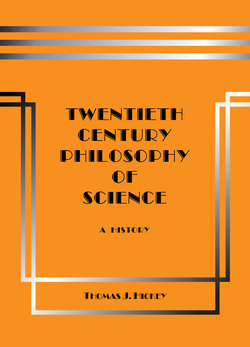Читать книгу Twentieth-Century Philosophy of Science: A History (Third Edition) - Thomas J. Hickey - Страница 24
На сайте Литреса книга снята с продажи.
Thesis I: Relativized semantics.
ОглавлениеThe seminal work is “Quantum Mechanics and a Talk with Einstein (1925-1926)” in Heisenberg’s Physics and Beyond. There Heisenberg relates that in April 1925, when he presented his matrix-mechanics to the prestigious Physics Colloquium at the University of Berlin, Einstein, who was in the assembly, afterward invited him to chat in his home that evening. In their conversation Einstein said that he no longer accepts the positivist view of observation including such positivist ideas as operational definitions. Instead he issued the aphorism: “the theory decides what the physicist can observe”.
Einstein’s view of observation contradicts the fundamental positivist thesis that there is a dichotomous separation between the semantics of observation language and that of theory language. Positivists believed that the objectivity of science requires that the vocabulary and semantics used for incorrigible observation must be uncontaminated by the vocabulary and semantics of speculative and provisional theory.
In the next chapter titled “Fresh Fields (1926-1927)” in the same book Heisenberg reports that Einstein’s discussion with him in Berlin had later occasioned his own reconsideration of observation. Heisenberg recognized that classical Newtonian physical theory had led him to conceptualize the observed track of the electron as continuous in the cloud chamber – an instrument for microphysical observation developed by 1927 Nobel-laureate C.T.R. Wilson – and to misconceive the electron as simultaneously having a definite position and momentum like all Newtonian bodies in motion.
Recalling Einstein’s aphorism that the theory decides what the physicist can observe, Heisenberg reconsidered what is observed in the cloud chamber. Einstein had failed to apply his aphorism to quantum theory, and rejected duality. But Heisenberg rephrased his question about the electron tracks in the cloud chamber using the concepts of the new quantum theory instead of those of the classical Newtonian theory. He reports that he asked himself: Can the quantum mechanics represent the fact that an electron finds itself approximately in a given place and that it moves approximately at a given momentum? In answer to this newly formulated question he found that these approximations could be represented mathematically. He then developed this mathematical representation, which he called the “uncertainty relations”, the historic contribution for which he received the Nobel Prize in 1932.
Russell Hanson expressed Einstein’s aphorism that the physical theory decides what the physicist can observe by saying observation is “theory-laden” and likewise Karl Popper by saying it is “theory-impregnated”.
Paul Feyerabend also recognized employment of relativized semantics to create new observation language for discovery, and he called the practice “counterinduction”. Feyerabend found that Galileo had practiced counterinduction in the Dialogue Concerning the Two Chief World Systems (1632), where Galileo reinterpreted apparently falsifying observations in common experience by using the concepts of the heliocentric theory instead of the concepts of the geocentric theory. Likewise Heisenberg also practiced counterinduction to reconceptualize the perceived sense stimuli observed as the electron track in the cloud chamber by using quantum concepts instead of classical Newtonian concepts.
“Counterinduction” is using the semantics of an apparently falsified theory to revise the test-design language that had supplied the semantics of the descriptive language for the falsifying observations, and thereby to produce new observation language.
Like Einstein, contemporary pragmatists say that the theory decides what the scientist can observe. Thus semantics is relativized in the sense that the meanings of descriptive terms used for reporting observations are not just names or labels for phenomena, but rather are determined by the context in which they occur. More specifically in “Five Milestones of Empiricism” in his Theories and Things the pragmatist philosopher of language Willard van Quine says that the meanings of words are abstractions from the truth conditions of the sentences that contain them, and that it was this recognition of the semantic primacy of sentences that give us contextual definition.
Most notably the defining context includes universal statements that proponents believe are true. The significance is that the acceptance of a new theory superseding an earlier one and sharing some of the same descriptive terms produces a semantical change in the descriptive terms shared by the theories and by their observation reports.
Thus Einstein for example changed the meanings of such terms as “space” and “time”, which occur in both the Newtonian and relativity theories. And Heisenberg changed the meanings of the terms “wave” and “particle”. Feyerabend calls the semantical change due to the relative nature of semantics, “meaning variance”.
